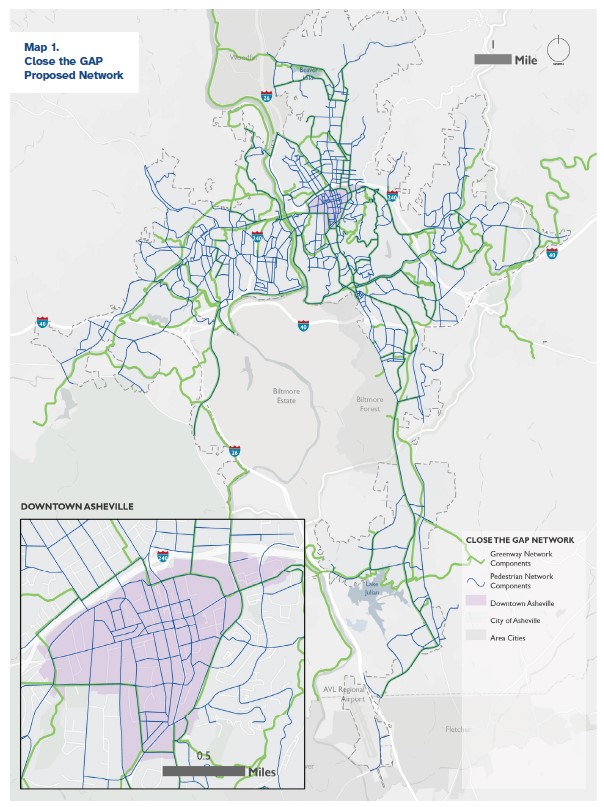By Nikki Gensert
Asheville’s Planning and Zoning Commission voted unanimously to recommend a plan for improving multimodal connectivity in Asheville at its meeting June 1. The 254-page Close the GAP proposal collates plans for greenways, compliance with the Americans with Disabilities Act and pedestrian infrastructure into a single guiding document.
As presented by Lucy Crown, the city’s greenways program planner, Close the GAP combines a proposed map of greenway and pedestrian networks with updates to city policies and design standards. Asheville City Council is scheduled to vote on the proposal Tuesday, July 26.
The greenways portion of the plan focuses on the creation of new greenways and natural-surface trails. It defines different types of greenways, with smaller neighborhood greenways and “arterials” like the Reed Creek Greenway feeding into high-capacity “spines” like the Wilma Dykeman Greenway in the River Arts District, and creates guidelines for the larger paths such as lighting and size requirements. The plan also includes networks of natural-surface trails on public land in the city that would be built in collaboration with nonprofit partners such as Asheville on Bikes, the Pisgah Area SORBA and Connect Buncombe.
The ADA transition plan identifies accessibility improvements needed for existing infrastructure, such as adding curb ramps for wheelchair users and audible street crossing signals for people with limited vision. And the pedestrian plan identifies gaps in the sidewalk network, with top city priorities including Lexington Avenue, Hilliard Avenue and Deaverview Road.
Close the GAP also includes recommendations for changes to the city’s Unified Development Ordinance and the Asheville Standards Specifications and Details Manual. Many changes fall under Chapter 7 of the UDO, which concerns development; examples include designating a specific member of the Technical Review Committee to review ADA compliance and strengthening requirements for developers to add sidewalks when building new projects.
Commissioner Geoffrey Barton clarified that those changes were only recommendations and would not yet commit the city to action. If the plan were adopted by Council, city staff would craft specific language to change the UDO and ASSDM that would be approved separately. Crown said some changes could happen within six months to a year of the plan’s adoption, but more substantive tweaks would likely take longer.
Barton also asked about funding sources for the proposed ADA improvements. He pointed out that the plan estimates a cost of $122 million for its outlined accessibility upgrades, with the implementation schedule and approximate annual budgets for that work all to be determined.
“I do want to make sure that accessibility doesn’t get overlooked,” Barton said. “It’s easy, when putting together funding applications, [to focus on] greenways. You know, they’re exciting; they have a tourism overlap. But the accessibility piece is extremely important.”
Crown said that Asheville currently has dedicated $150,000 in recurring annual funds to those upgrades. She pointed out that many ADA compliance projects are completed as part of resurfacing projects and that the exact amount required hasn’t been calculated yet. The city is hoping to create a 35-year implementation schedule with identified funding for ADA improvements.
The full Close the GAP draft is available online at avl.mx/bno.
P&Z hears sustainability update
Commissioners also heard a presentation from Bridget Herring, the city’s sustainability director. The commission had decided during a retreat earlier this year that it would like to hear more presentations from other city departments about their work and its relationship to planning and zoning.
Herring said her office has recently been focusing on the city’s Climate Justice Initiative, a goal of using 100% renewable energy sources for city buildings by 2030 and a new program called Save the Food AVL, which allows residents to drop off food waste to be used for compost. The department is also working on updating the city’s Sustainability Management Plan into a Municipal Climate Action Plan.
The latter document, passed in 2009, does not reflect many of the resolutions since updated or passed by the city, including its 2020 climate emergency declaration. Although a 2021 document developed by AECOM, a consultant hired by Asheville to assist with the work, said the Municipal Climate Action Plan would be completed by January 2022, Herring told commissioners that it is now expected to be published in the coming winter.
Commission Chair Joe Archibald asked if there was anything that could be added to zoning requirements to make an impact on sustainability. Herring suggested expanding the benefits table that is currently used for hotels to other zoning districts. That program allows hotels to gain automatic approval from city staff if they meet certain criteria, such as certifying construction under the U.S. Green Building Council’s LEED program or including solar energy production.
Asheville is limited by state law regarding what it can require through zoning, Herring continued, so having a benefits table is a good way to encourage sustainability in new developments. Todd Okolichany, the city’s director of planning and urban design, said he had heard similar recommendations from members of City Council and would be pursuing the work over the next fiscal year.
Herring’s full presentation is available online at avl.mx/bnp.



Before you comment
The comments section is here to provide a platform for civil dialogue on the issues we face together as a local community. Xpress is committed to offering this platform for all voices, but when the tone of the discussion gets nasty or strays off topic, we believe many people choose not to participate. Xpress editors are determined to moderate comments to ensure a constructive interchange is maintained. All comments judged not to be in keeping with the spirit of civil discourse will be removed and repeat violators will be banned. See here for our terms of service. Thank you for being part of this effort to promote respectful discussion.